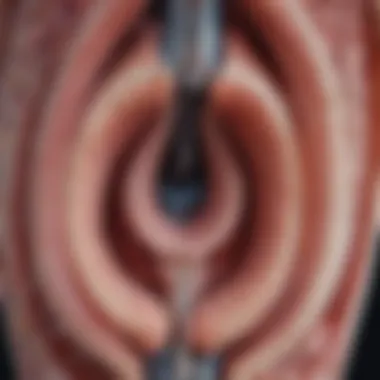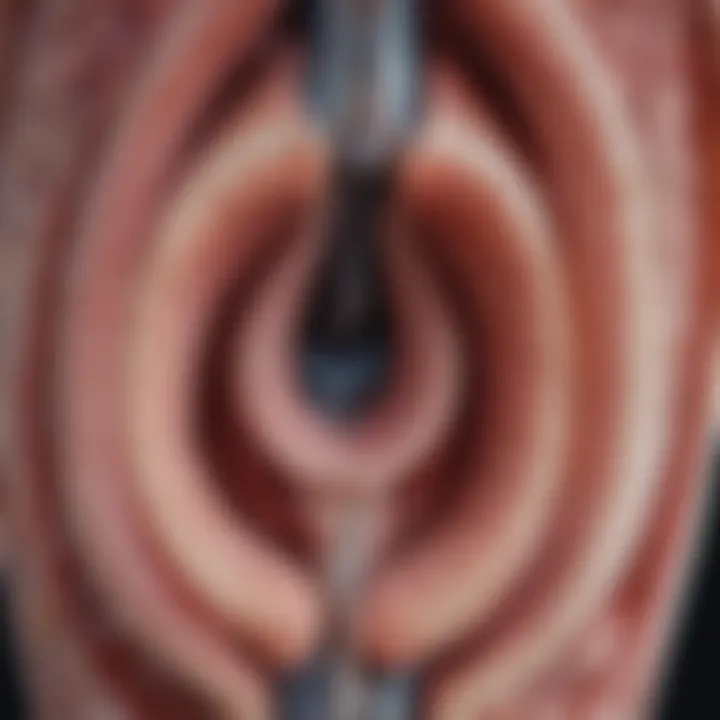Understanding Severe Pain in the Urethra: Causes & Treatments


Intro
Severe pain in the urethra is a distressing symptom that can significantly impact one's quality of life. Understanding its underlying causes is crucial for effective diagnosis and treatment. The urethra, a tube that connects the bladder to the exterior of the body, serves an essential role in urinary function. If one experiences pain in this area, it can signify various health issues ranging from infections to injuries.
This article aims to explore the anatomy of the urethra and the common symptoms associated with its severe pain. Identifying potential underlying conditions is pivotal in guiding the diagnostic process. Additionally, we will cover the treatment options available and offer preventive measures to enhance urological health. The insights provided here will benefit not only patients but also healthcare professionals seeking a deeper understanding of urethral pain and its implications.
Anatomy of the Urethra
Understanding the anatomy of the urethra is crucial in the context of severe urethral pain. The urethra serves as a vital conduit for urine expulsion from the bladder. Any dysfunction or pain can significantly affect a person's quality of life. Therefore, a clear comprehension of its structure and function is essential, not only for medical professionals but also for individuals experiencing symptoms. Recognizing the specific characteristics of the urethra can aid in pinpointing the potential causes of pain.
Structure and Function
The urethra is a tubular structure that facilitates the outflow of urine from the urinary bladder to the exterior of the body. Its length varies, averaging around 4 cm in females and 20 cm in males. This considerable difference in length is significant in understanding the distinct urological health concerns that affect each gender.
Fundamentally, the urethra contains layers of smooth muscle and mucosa, which play an essential role in its function. The internal sphincter, which is comprised of smooth muscle, is responsible for involuntarily controlling urine flow. Meanwhile, the external sphincter is under voluntary control, allowing individuals to manage urination more consciously. Moreover, lymphatics and blood vessels supply the urethra, which is necessary for maintaining its health and function.
A comprehensive understanding of the urethral structure provides valuable insights into how different conditions can lead to pain. For instance, infection or injury to any part of the urethra can severely disrupt its natural function, resulting in discomfort or pain. Each segment within the urethra also has distinct features, which can define specific types of pain or conditions affecting it.
Differences Between Male and Female Urethra
The male and female urethra exhibit notable anatomical differences that warrant attention when considering urethral pain. The female urethra, being shorter and broader, may be more susceptible to certain types of infections such as urinary tract infections. The proximity to the anus also increases its risk of bacterial contamination.
In contrast, the male urethra's length and its dual function—serving both urine and semen—introduces complexities related to prostate health. Conditions like prostatitis can cause referred pain in the urethra, complicating diagnosis and treatment.
The urethra's anatomy plays a crucial role in understanding both the symptomology and the potential ailments affecting urinary health.
Understanding Urethral Pain
Understanding urethral pain is crucial for identifying its potential causes and ramifications, which can significantly affect an individual's quality of life. The urethra, as a vital part of the urinary system, plays a key role in removing waste from the body. Pain in this area is not just a symptom; it is a signal that something may be wrong. By comprehending the nature of urethral pain, one can make informed decisions about seeking medical attention and exploring treatment options.
The understanding of urethral pain incorporates multiple layers, including recognizing the underlying conditions that may contribute to such pain. Awareness can lead to earlier diagnosis and intervention, which can mitigate further complications. Additionally, understanding the terminology used in diagnosing and describing urethral pain enhances communication with healthcare providers. This can result in a more comprehensive approach to management and treatment.
Definition of Urethral Pain
Urethral pain refers to discomfort or pain experienced in the urethra, the tube that transports urine from the bladder to the outside of the body. It may vary in intensity and nature, manifesting as a sharp, burning sensation during urination or a dull ache in the lower abdomen. Urethral pain can occur independently or as part of a broader set of symptoms linked to urinary tract dysfunction. It is often associated with other urinary symptoms, such as urgency or frequency, which contribute to its classification and assessment.
This pain can stem from various factors, including infections, injuries, or inflammatory conditions. Due to its location, patients often report urethral pain in conjunction with discomfort in neighboring areas of the body. Recognizing these symptoms helps in guiding diagnostics.
Characteristics of Severe Pain
Severe urethral pain often presents distinct characteristics that set it apart from mild discomfort. Patients may describe it as excruciating or unbearable, significantly interfering with daily activities. Common characteristics include:
- Intense Sharpness: This pain often has a sharp quality that is difficult to ignore.
- Burning Sensation: A burning feeling, especially during urination, is frequently noted.
- Referral of Pain: Pain might radiate to surrounding areas, including the lower abdomen and pelvic region.
- Duration: Severe pain can be persistent, failing to subside even with the passage of urine.
- Associated Symptoms: It may occur alongside other symptoms like fever, chills, or blood in the urine, indicating a more serious underlying condition.
Understanding these characteristics can assist both patients and healthcare professionals in determining the urgency and potential cause of the pain. Early recognition can facilitate appropriate treatment and management plans.
Common Symptoms Accompanying Urethral Pain
Understanding the common symptoms accompanying urethral pain is essential for both diagnosis and treatment. These symptoms often serve as critical indicators of underlying conditions and help in determining the severity of the situation. Awareness of these signs can lead to timely medical intervention, which can significantly improve patient outcomes. The symptoms can vary widely among individuals, but key ones often include dysuria, lower abdominal pain, and changes in urinary frequency.
Dysuria and Its Implications
Dysuria, or painful urination, is one of the most prevalent symptoms associated with urethral pain. It is characterized by a burning sensation during urination, which can lead to significant discomfort. The implications of dysuria extend beyond immediate pain; it may suggest the presence of an infection, such as a urinary tract infection or sexually transmitted infection.
Recognizing dysuria helps in understanding the urgency of medical evaluation. If neglected, the underlying condition may worsen, potentially affecting the kidneys or spreading infection. Patients experiencing dysuria are advised to seek medical attention promptly, as laboratory tests like urinalysis can distinguish between different potential causes. Persistent dysuria can be distressing and impact daily activities, highlighting its significance in the discussion of urethral pain.
Associated Lower Abdominal Pain
Another common symptom that often accompanies urethral pain is associated lower abdominal pain. This type of pain can vary from a dull ache to sharp discomfort and might arise from various causes. It may indicate bladder conditions, infections, or even complications from kidney stones.


Such discomfort can alter a person's routine, as it may lead individuals to avoid certain activities or positions that exacerbate the pain. Moreover, the presence of lower abdominal pain can help healthcare providers narrow down possible diagnoses, especially if correlated with other symptoms like dysuria. It is also a signal that further investigation might be necessary, highlighting the interconnected nature of urological symptoms.
Frequency and Urgency of Urination
Lastly, frequency and urgency of urination are symptoms that often coexist with urethral pain. Individuals may find themselves needing to urinate more frequently than usual, sometimes with little output. Urgent feelings to urinate can occur suddenly, leading to anxiety about potential accidents.
These symptoms underscore the potential dysfunction in the urinary system. Increased frequency and urgency can stem from conditions like urinary tract infections, bladder irritation, or even interstitial cystitis. They can significantly affect the quality of life, making routine activities complicated. Being aware of these changes can assist individuals in recognizing when professional medical advice is needed.
The combination of dysuria, lower abdominal pain, and changes in urinary patterns provides critical insights for healthcare providers, facilitating accurate diagnoses and prompt treatment.
In summary, understanding the common symptoms accompanying urethral pain enriches the dialogue on this condition. Each symptom—dysuria, associated lower abdominal pain, and changes in urinary frequency—plays a crucial role in diagnosis and may signal underlying issues requiring attention. Integrated knowledge of these symptoms not only aids in accurate diagnosis but also empowers patients to seek timely care, thus enhancing their urological health.
Potential Causes of Severe Urethral Pain
The potential causes of severe urethral pain are essential to understand because they provide the foundation for diagnosing and treating this distressing condition. Recognizing these causes allows healthcare professionals to tailor treatment plans effectively, aiming to address not just the symptom of pain but also the underlying issues that contribute to it. The exploration of these causes can guide patients toward informed decisions regarding their health.
Infections
Infections are one of the foremost contributors to severe urethral pain. They can originate from various pathogens and lead to significant discomfort and distress.
Urinary Tract Infections
Urinary Tract Infections (UTIs) are a common source of urethral pain. A UTI occurs when bacteria invade the urinary system, inflaming the urethra and bladder. The key characteristic of UTIs is the sharp, burning sensation during urination, which often accompanies frequent urges to urinate. This condition is a popular inclusion in discussions about urethral pain because of its prevalence and recognizability. The unique feature of UTIs is their capability to escalate if untreated, leading to more severe dysfunctions and complications within the urinary system. Treatment typically involves antibiotics, allowing for swift relief and restoration of health.
Sexually Transmitted Infections
Sexually Transmitted Infections (STIs) also contribute significantly to urethral pain. STIs such as gonorrhea and chlamydia can inflame the urethra, causing both pain and discomfort. The key characteristic of STIs is their mode of transmission—direct sexual contact—which makes understanding and prevention critical. The unique aspect of STIs in the context of urethral pain is their potential to cause long-term complications if not treated promptly. Therefore, educatin on safe practices is crucial in prevention and early detection.
Urethral Injury
Urethral injury is another cause of severe pain that can arise from various factors including trauma or surgical procedures. Such injuries elicit a tangible pain response that can severely affect a person's quality of life. The immediate effects can include bleeding, swelling, and significant discomfort during urination. Recognizing urethral injury as a cause is important as it requires specific clinical attention, usually involving imaging studies and possibly surgical intervention if the injury is severe.
Inflammatory Conditions
Inflammatory conditions can cause severe urethral pain through diverse mechanisms. Among these inflammatory conditions, urethritis and interstitial cystitis are particularly noteworthy.
Urethritis
Urethritis is the inflammation of the urethra, often due to infections. The primary aspect of urethritis in the context of severe pain is its symptomology, characterized by intense irritation and frequent urination. It is beneficial to include urethritis in discussions about urethral pain due to its direct impact on the urethra itself. The unique feature is that it can be acute or chronic, leading to differing treatment approaches. Chronic urethritis may require a more comprehensive treatment regimen, making awareness of this condition crucial for patients experiencing lasting pain.
Interstitial Cystitis
Interstitial Cystitis is a chronic condition resulting in bladder pressure, leading to pain and discomfort that often radiates to the urethra. The key characteristic of interstitial cystitis is its unpredictability; episodes can vary drastically in intensity. It deserves mention due to its persistent nature, often necessitating a multifaceted approach to management including dietary changes and physical therapy. Being educated about interstitial cystitis is paramount as it can present significant long-term challenges for those affected.
Urological Disorders
Urological disorders, such as kidney stones and prostatitis, can also lead to severe urethral pain.
Kidney Stones
Kidney stones form in the kidney and may migrate down the urinary tract, causing sharp, intense pain as they pass through the urethra. This aspect of kidney stones is crucial to understanding as the pain associated with stones often emerges suddenly and can be debilitating. The unique feature of kidney stones is their painful passage, which requires urgent management. Treatment may involve pain relief, increased hydration, and sometimes medical procedures to facilitate their removal.
Prostatitis
Prostatitis refers to inflammation of the prostate gland, which can lead to urethral pain as well. This condition is critical because it affects a significant number of males at various ages. The characteristic of prostatitis is its potential for both acute and chronic forms, influencing treatment strategies. The unique aspect of prostatitis is its tendency to complicate urinary issues and its psychosocial impact. Effective management may involve antibiotics, anti-inflammatory medications, and lifestyle adjustments.
In summary, understanding the potential causes of severe urethral pain is pivotal for diagnosis and treatment. Each condition has its own implications, making it crucial for patients to seek medical attention when experiencing such symptoms.
Diagnostic Approaches
Diagnosing severe pain in the urethra requires a comprehensive approach. Understanding various diagnostic methods is crucial for accurately identifying the underlying cause of the pain. These methods not only aid in treatment decisions but also help in assessing the severity and potential complications of the condition. Here, we will explore three main diagnostic approaches: physical examination, urinalysis and urine culture, and imaging tests.


Physical Examination
A physical examination is often the initial step in the diagnostic process. During this examination, healthcare providers look for signs of any abnormalities in the urinary tract as well as associated symptoms. This includes palpating the abdomen and examining the genitals. A thorough assessment can provide valuable clues about the source of the pain. For instance, tenderness in the lower abdomen may point to an infection, while any visible swelling might indicate an injury. The examination also helps providers gauge how the pain affects the patient's daily life and functioning.
Urinalysis and Urine Culture
Urinalysis is a common test performed to evaluate the contents of urine, which can indicate various conditions affecting the urethra. Healthcare professionals check for the presence of blood, bacteria, or crystals. A urine culture, which is a more specific test, identifies the bacteria responsible for a urinary tract infection. This test is vital for determining the appropriate antibiotic treatment. Moreover, the quick results of these tests make them particularly beneficial in reducing the waiting period for diagnosis and treatment initiation.
Imaging Tests
Imaging tests are essential tools in diagnosing severe urethral pain when physical examination and urinalysis do not provide clear answers. Two primary types of imaging tests are used, each offering unique benefits.
Ultrasound
Ultrasound is a non-invasive imaging technique that uses sound waves to produce images of the internal structures of the body. It is especially useful for evaluating the kidneys, bladder, and surrounding tissues. The key characteristic of ultrasound is its ability to provide real-time images without the need for ionizing radiation. This is particularly valuable for patients who may require multiple imaging sessions.
- Advantages of Ultrasound include:
- Non-invasive and safe
- No exposure to radiation
- Can help visualize fluid collections or abnormalities in the urinary tract
However, ultrasound has limitations. It may not provide as detailed images as other modalities, which can be important for diagnosing certain conditions.
CT Scans
CT scans offer a more detailed view compared to ultrasound, as they combine multiple X-ray images to produce cross-sectional images of the body. This type of imaging is beneficial in identifying stones, tumors, or other significant abnormalities in the urinary tract. The key characteristic of CT scans lies in their ability to provide high-resolution images in a relatively short amount of time.
- Unique features of CT Scans:
- Highly detailed images allow for precise diagnosis
- Rapid acquisition of images, making it useful in emergency situations
However, the use of CT scans involves exposure to a small amount of radiation and may require the use of intravenous contrast material, which is contraindicated in some patients.
In summary, a comprehensive diagnostic approach including physical examination, urinalysis, and imaging tests is essential for understanding severe urethral pain. Each method has its own benefits and limitations, contributing to a fuller picture of the patient's condition that guides effective treatment.
Treatment Options for Urethral Pain
The treatment of urethral pain is crucial to alleviating discomfort and addressing the underlying causes. Effective management can lead to improved quality of life, increased functionality, and reduced complications. A tailored approach, considering individual circumstances, often yields the best results. Treatment options can range greatly, from medications to therapeutic interventions. It is essential to note that the selection of a treatment method adheres to the underlying cause of the pain.
Medications
Antibiotics
Antibiotics are a primary treatment option when infections are the source of urethral pain. They work to eliminate bacteria responsible for urinary tract infections or sexually transmitted infections. The key characteristic of antibiotics is their ability to specifically target and destroy harmful pathogens without affecting body cells significantly. This is particularly beneficial for those experiencing pain due to infectious processes. However, they require a proper diagnosis before prescribing to ensure the right type is used. Overuse or misuse of antibiotics can lead to resistance, which is an emerging global health concern.
Pain Relievers
Pain relievers, such as nonsteroidal anti-inflammatory drugs (NSAIDs), play an important role in managing severe pain. They help reduce inflammation and alleviate discomfort associated with conditions affecting the urethra. The key advantage of pain relievers is their broad availability and ease of use. Most can be obtained without a prescription, providing immediate relief. Nevertheless, they do not treat the root cause of the pain. This can lead to reliance on them while the actual problem persists, making it crucial to follow up with a healthcare provider to address underlying issues.
Management of Underlying Conditions
Management of underlying conditions is essential to alleviate urethral pain. This approach may involve a comprehensive treatment plan focusing on conditions like urethritis or interstitial cystitis. Managing these conditions may require a combination of treatments, such as medications and lifestyle adjustments. Early identification and intervention are key to preventing further complications and ensuring optimal recovery.
Therapeutic Interventions
Physical Therapy
Physical therapy can be an effective treatment for urethral pain by improving pelvic floor function. It involves techniques aimed at strengthening and relaxing pelvic muscles. The key feature of physical therapy is its focus on physical techniques to address pain. This is beneficial for individuals whose pain arises from muscular tension or dysfunction. However, patients must commit to routine visits and exercises. Compliance and commitment are critical factors influencing outcomes in this therapy.
Urethral Dilation Procedures
Urethral dilation procedures are another option for treating severe urethral pain, particularly when narrowing or strictures are present. The process involves stretching the urethra to alleviate constriction. This procedure can provide immediate symptom relief. Its primary advantage is that it addresses mechanical issues causing pain. However, there is a risk of complications, including infection or recurrence of strictures, warranting thoughtful consideration prior to proceeding.


Preventive Measures
Preventive measures play a critical role in reducing the occurrence of severe pain in the urethra. By adopting specific habits and practices, individuals can mitigate the risk of developing conditions that lead to urethral pain. Emphasis on preventive strategies can enhance overall urological health and contribute to a better quality of life.
Hygiene Practices
Maintaining proper hygiene is essential for preventing various infections that can lead to urethral pain. Good cleanliness practices help in minimizing the exposure to bacteria and irritants.
- Daily Cleaning: Gently wash the genital area with mild soap and water daily.
- Wipe Front to Back: For females, always wipe from front to back after using the restroom to prevent bacteria from the anal area entering the urethra.
- Wear Breathable Fabrics: Choose cotton underwear and avoid tight-fitting clothing to reduce moisture buildup, which could encourage bacterial growth.
- Avoid Irritants: Limit the use of scented soaps, feminine sprays, and other products that may irritate the urethra.
These hygiene practices serve as the first line of defense against infections and inflammation.
Hydration and Diet
Staying well-hydrated is another effective preventive measure. Proper hydration helps maintain urinary tract health and can prevent some painful conditions.
- Drink Plenty of Water: Aim for at least 8 glasses of water a day to help flush out bacteria from the urinary system.
- Limit Irritating Foods and Drinks: Cut back on caffeine, alcohol, spicy foods, and acidic foods like citrus fruits. These can irritate the bladder and urethra, leading to discomfort.
- Balanced Diet: Ensure a diet rich in fruits, vegetables, and whole grains to support immune function and overall health. A healthy diet may also help in preventing urinary tract infections.
Proper hydration and a well-balanced diet are key in maintaining urinary tract health and preventing painful conditions like urethritis.
By following these preventive measures, individuals can significantly reduce the risk of severe pain in the urethra and improve their overall well-being.
When to Seek Medical Attention
Understanding when to seek medical attention for urethral pain is crucial for effective management and preventing complications. Severe pain in the urethra can be alarming for individuals, and recognizing when it signifies a serious underlying condition is essential. It may vary from mild discomfort to excruciating pain, and some instances warrant immediate medical evaluation. This section will explore key indicators suggesting when prompt intervention is necessary.
Indications of Severity
Certain symptoms can help differentiate between mild discomfort that may resolve on its own and severe pain that demands medical attention. Key indicatons of severity include:
- Intense pain that is persistent and not alleviated by over-the-counter pain relievers.
- Blood in urine, medically known as hematuria, is a sign of possible injury or infection that requires further investigation.
- Fever or chills, as these symptoms often accompany infections that can escalate quickly if not treated.
- Signs of shock, such as rapid breathing or a feeling of faintness, which can indicate a serious condition requiring immediate action.
If any of these symptoms develop alongside urethral pain, it is advisable to consult a healthcare professional without delay.
Emergency Situations
Some situations dictate emergency intervention. These may include:
- Sudden onset of severe pain that is drastically different from usual experiences.
- Inability to urinate, which could signal an obstruction in the urinary tract needing urgent medical assessment.
- Severe abdominal pain along with urethral symptoms, suggesting that a more complex issue may be at play, possibly involving other organs.
- Signs of an allergic reaction, such as swelling in the throat, face, or lips, especially after consuming new medications or undergoing treatments.
It is vital to take emergency symptoms seriously. Not addressing them can lead to complications that may compromise urological health.
Finale
In concluding this exploration into severe pain in the urethra, it is essential to recognize the complex nature of urological health. This article has illuminated various causes ranging from infections to structural disorders that can lead to significant discomfort. Understanding the anatomy of the urethra, distinguishing between male and female structures, and recognizing individual pain characteristics are foundational in addressing this issue.
Importance of Recognizing Symptoms
Being able to identify symptoms such as dysuria, frequency, and urgency enhances the effectiveness of primary healthcare measures. Recognizing these indicators early can facilitate prompt intervention and potentially mitigate more severe complications.
Comprehensive Approach to Diagnosis
The article illustrates that appropriate diagnostic methodologies, like urinalysis and imaging tests, are vital. Such approaches play a critical role in distinguishing between different causes, allowing for more tailored treatment options. By understanding these diagnostics, individuals are empowered to take active roles in their healthcare.
Treatment and Prevention
Additionally, the discussion on various therapeutic measures emphasizes structured management plans that professionals must execute. Treatment effectivey addresses underlying issues, thereby relieving severe pain. Preventive measures, including proper hygiene and adequate hydration, cannot be overlooked. These practices significantly reduce the risk of developing conditions leading to urethral pain.
Final Thoughts
In summary, this investigation offers valuable insights into urethral pain and its implications. For students, researchers, educators, and healthcare professionals, understanding these various aspects is key to enhancing patient outcomes. This knowledge serves as a crucial tool for better urological health, ensuring those affected are informed and able to seek appropriate medical assistance when necessary.
"Education is not the learning of facts, but the training of the mind to think."
- Albert Einstein
By synthesizing the information discussed, we encourage a holistic view of urological concerns while also fostering a deeper understanding within the community. This understanding is vital in reducing stigma and promoting awareness about urinary health conditions.



